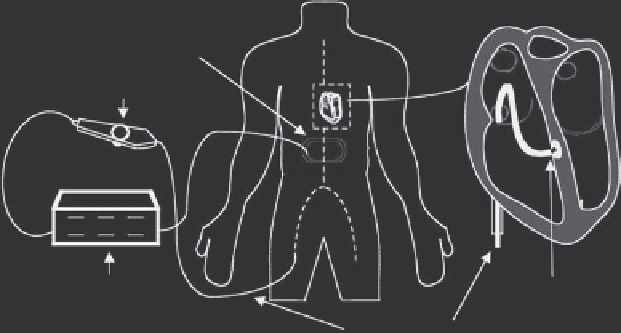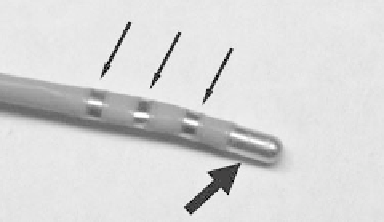Biomedical Engineering Reference
In-Depth Information
Reference patch electrode
on the dorsal side
Handle
RF generator
Ablation electrode
Catheter body
FIGURE 9.7
Schematics of cardiac RF ablation system. A cardiac RF catheter is inserted through a leg vein and steered to the target site inside
the heart (right figure). A reference patch electrode (i.e., ground pad) is placed on the patient's back. The small black region around the RF electrode
at the catheter tip depicts the ablation zone. (Reproduced with permission from Panescu, D., Whayne, J.G., Fleischman, S.D., Mirotznik, M.S.,
Swanson, D.K., and Webster, J.G.,
IEEE Transactions on Biomedical Engineering
42, 1995. © IEEE.)
use internal or external cooling to increase ablation zone size
(see also Section 9.2).
One very common type of cardiac arrhythmia that affects
~2.2 million people in the United States (most prevalent among
people older than 60 years) is atrial fibrillation, where the atria
quiver instead of beat, thereby reducing the pumping perfor-
mance of the heart, with a risk of blood clot formation (Wilber
2007). Cardiac ablation is increasingly used for treatment of
atrial fibrillation in patients not responsive to medications. For
treatment of atrial fibrillation, multiple linear, contiguous abla-
tion zones have to be created. This is difficult and time consum-
ing with current devices, resulting in long procedural times and
high recurrence rates (Wilber 2007). New devices that allow
more rapid and reliable creation of linear ablation zones are in
development (Burkhardt 2009, Siklody 2010).
whole endometrium (i.e., lining of the uterus) is ablated within
typically 3-10 minutes. Different methods are employed to ther-
mally ablate the endometrium, including RF ablation devices
that employ mesh electrodes with power applied between two
electrically insulated meshes (Cooper 2004).
RF and laser-based ablation devices are available as treat-
ment modality for varicose veins (Markovic 2009) (endovas-
cular ablation), which are visible, dilated and twisted veins
near the skin surface. Varicose veins most often affect legs and
thighs, due to blood pooling and vein enlargement resulting
from insufficiencies in the venous valves. The treatment goal
is typically closure of the affected veins. Methods to obtain
vein closure include surgical stripping, injection of a drug
that results in vein swelling and closure, and ablation. During
ablation, a catheter is introduced into the vein, and the vessel
wall is heated, resulting in collagen shrinkage and closure of
the vein.
9.3.3 Other applications of rF ablation
RF ablation is clinically used for treatment of uterine bleeding in
women who don't respond to standard therapies such as medi-
cation and scraping of the endometrium. During treatment, the
9.4 Biophysics of Microwave ablation
Microwaves represent the portion of the electromagnetic spectrum
between 300 MHz and 300 GHz. The Federal Communications
Commission (FCC) or International Telecommunications Union
(ITU) permit several unrestricted frequency bands for indus-
trial, scientific, and medical use in several regions of the world,
including those most commonly used for microwave ablation
procedures today: 915 MHz and 2.45 GHz. In addition to these
two frequencies, 433 MHz has been explored as an option for
microwave hyperthermia in Europe, but not commonly for high-
temperature focal microwave ablation. Frequencies higher than
2.45 GHz can also be used for some applications but have not been
widely explored to date.
As with other thermal ablation modalities, microwave abla-
tion describes the rapid destruction of tissue by microwave
FIGURE 9.8
Cardiac RF ablation catheter (7F = 2.3 mm diameter).
Several electrodes are located along the catheter: RF electrode of 4mm
length (large arrow), as well as three smaller electrodes used for record-
ing of local electrical activity in the heart (small arrows).


